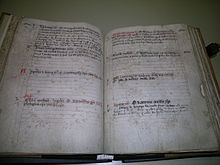Obituary
![]()
The articles Necrology and Obituary overlap thematically. Information that you are looking for here may also be found in the other article.
You are welcome to participate in the relevant redundancy discussion or to help directly to merge the articles or to better distinguish them from one another (→ instructions).
Nekrolog [nekroˈloːk], from Middle Latin necrologium ("register of the dead"), a neologism (not a loanword!) from the Greek word roots (νεκρὀς nekrós "dead, dead person" and λἐγειν légein "(to) read, collect; to speak, to speak") denoted since the Middle Ages a register of the dead kept in monasteries and convents. In 1813 Joachim Heinrich Campe still translated it as "Todtenbuch, Todtenhalle, Todtensaal".
It was not until modern times that a second meaning emerged, which has been the dominant one today since Schmid and Schlichtegroll: presentation of the biography and appreciation of the life's work of a deceased person. Frequently the appreciations of persons who have died within a calendar year are also published under this title. The novelty here is that the necrology goes beyond the register-like collection of data and deals in detail with the personality of the deceased. From its emergence until the middle of the 19th century, there was no Germanization for necrology in the meaning of appreciation of a deceased. Only since this time did the German word Nachruf, which had previously only been used literally ("Nach-rufen"), become established as a synonym for necrology through an extension of meaning.
In recent times, moreover, any form of public or published commemoration of the dead is sometimes referred to as a necrology. This definition is controversial, since it is also extended to epochs in which the neologism necrology did not yet exist or did not have the modern meaning. Then, in fact, the designation represents a classic anachronism.
An obituary for celebrities today is usually published in the print media, but there are also cinematic obituaries.
Middle Ages
From the Middle Ages, registers of the dead in monasteries and foundations are known, which are called necrologies (sg. the necrology, in the spelling of the time Necrolog(ium)) or also obituaries (sg. Obituarium or Obituar). In these registers the names of those who were to be remembered in prayer were noted. Important necrologies have been preserved, for example, from the monasteries of Fulda, Prüm and Lorch. From the late Middle Ages onwards, corresponding registers, for which the term "Jahrzeitbuch" (yearbook) became common in German, were kept in most monasteries, foundations and parish churches.
Main article Yearbook
See also: Dead Man's Robe

Medieval necrology manuscript from Essen Abbey (ca. 1300). The week from 12 to 18 August is marked with the entry of the founder of the monastery, Altfrid, on 15 August.
Modern Times
In the late 18th century, Christian Heinrich Schmid (1746-1800) began publishing necrological yearbooks with his Nekrolog oder Nachrichten von dem Leben und den Schriften der vornehmsten verstorbene teutschen Dichter (1785) and Friedrich von Schlichtegroll (1765-1822) with his Nekrolog auf das Jahr [1791-1800], enthaltend Nachrichten von dem Leben merkwürdiger in diesem Jahr verstorbener Deutscher and Christian Friedrich Buchner with his Nekrolog für Freunde der deutschen Litteratur (1791-1794), which continued into the 19th century. Century were continued: Nekrolog der Teutschen (1802-1806); Neuer Nekrolog der Deutschen (1824-1854, ed. Georg Friedrich August Schmidt) or Biographisches Jahrbuch und deutscher Nekrolog (1897-1917).
Questions and Answers
Q: What is an obituary?
A: An obituary is a notice of a death that is published by the family of the person who died.
Q: Why do families publish obituaries?
A: Families publish obituaries to inform more distant family members and friends about the death.
Q: Who commonly publishes obituaries?
A: Funeral homes commonly publish obituaries.
Q: What information is usually included in an obituary?
A: An obituary usually includes a description of the person who died.
Q: Are funeral arrangements typically part of an obituary?
A: Yes, funeral arrangements are usually part of an obituary.
Q: How is an obituary distributed?
A: An obituary is distributed via a publication in a newspaper, or via manual handing out or posting of pamphlets.
Q: What service do some newspapers offer in relation to obituaries?
A: Some newspapers offer a service of writing a biography for the person who died, which can be included in the obituary.
Search within the encyclopedia